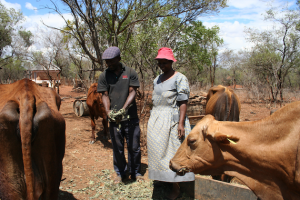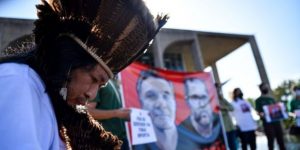
Cattle are important for economic growth and in supporting livelihoods across Africa. Livestock farmers in Nkayi, Zimbabwe, tending to their cattle. Credit: Busani Bafana/IPS
By Busani Bafana
Bulawayo, Oct 7 2022 – Meat, milk, and eggs are bad for you, and livestock is bad for the environment.
Growing negative narratives about cattle’s contribution to climate change are shrinking the growth of the strategic livestock sector on which the livelihoods of more than 1.3 billion people in the world depend.
In Africa, livestock farming is life, providing food, nutrition, jobs, draught power, income generation, and a source of cultural significance. But the benefits of keeping cattle, goats, sheep, and pigs are lost when it comes to the impact of livestock on the environment are mentioned.
As a result, livestock farmers are suffering from the low investment in the livestock sector, which has the potential to drive economic growth, address poverty and achieve many of the Sustainable Development Goals (SDGs).
Researchers, farmers, and entrepreneurs, lamenting the negative perception about livestock in contributing to climate change, are calling for a balanced discussion to highlight livestock production, not as a problem but as a solution in tackling climate change, especially in developing countries.
Ian Wright, Deputy Director at the International Livestock Research Institute (ILRI) in Nairobi, Kenya, admits that livestock production is today topical for its negative impact on the environment, an area where it can provide a solution. There are suggestions that milk, meat, and eggs are becoming foods to avoid, yet livestock is one of the fastest-growing economic sectors in Africa, he said.
“Livestock and livestock systems are very different in different regions of the world, and the cultural significance and economic importance varies but the contribution of livestock to food and nutrition security in Africa is absolutely critical,” Wright told IPS in an interview. He added that the majority of people in Africa tend not to eat adequate sources of protein and micronutrients, in contrast to the situation in the Global North, where people will benefit from eating less meat and animal-sourced foods.
We can ‘meat’ in the middle
“The global discussions around livestock tend to be dominated by voices from the Global North, so it is important we ensure that perspectives on the role of livestock from the Global South, including Africa, are heard at the top table of global events like the Conference of Parties (COP 27) to articulate the positives about the role of livestock which no doubt has its challenges,” Wright said.
“The livestock sector must address these shortcomings as there are opportunities to make livestock part of the resilience and adaptation efforts; for example, climate variability makes cropping too risky, but livestock can still be raised producing food from land that cannot produce crops.”
Better livestock management and improved feed regime can help reduce greenhouse gas (GHG) emissions from livestock, while sustainable rangeland management promotes the fixing of carbon in the soil.
Livestock production contributes to about 40 percent of the global value of agricultural output while supporting the livelihoods, food, and nutrition security of billions of people around the world, according to the United Nations Food and Agriculture Organization (Food and Agriculture Organisation (FAO).
A growing population and rapid urbanization are also driving an appetite for animal-sourced foods from eggs, milk, beef, and pork, which are also some of the best and often affordable sources of protein. Livestock provides energy-dense and micronutrient-rich foods, which are important for pregnant women and particularly babies in the first 1 000 days of life.
Scientists are clear about livestock’s huge hoof print. Assessments by the FAO show that total emissions from global livestock represent 14.5 percent of all human-induced GHG emissions. Cattle, in particular, are responsible for the most emissions, at about 65 percent of the livestock sector’s emissions, largely of dangerous methane gas. As a result, there is a growing movement to stop eating meat and instead tuck it into plant-based diets to promote health and save the environment.
However, Africa is one of the regions in the world where malnutrition is rising. More people are going hungry, and even more, have no access to nutritious food. Livestock is a solution.
The World Bank notes that Africa is losing between 3 and 16 percent of its GDP annually because of childhood stunting, and animal-sourced foods can contribute to reducing that problem, says Adegbola Adesogen, Director of the Food Systems Institute and the Feed the Future Innovation Lab for Livestock Systems at the University of Florida.
“We should prioritize livestock-sourced foods in nutrition and increase access to these foods across Africa because there is low consumption of animal-sourced foods in Africa, Adesogen urged. “For example, the consumption of meat in Nigeria is about less than five percent of what is consumed in Argentina, yet the animal-sourced foods contain a plethora of vital macro and micro nutrients which are vital for children of Africa for their growth and health yet most of the interventions address malnutrition in Africa neglect animal-sourced foods.”
Investing in livestock
The livestock sector attracts little investment compared to other agriculture sectors but contributes up to 40 percent of the agriculture GDP in Africa. Of the $129 billion Official Development Assistance in 2020, only 4,3 of that was funneled into agriculture, and livestock received just 1.3 percent, Wright noted.
Smallholder farmer, Emma Naluyima from Uganda, who has integrated crop growing and livestock in growing a thriving farm enterprise on an acre of land, says supportive policies are critical in promoting the development of the livestock and the livelihoods of livestock farmers.
Naluyima, speaking during a panel discussion at a session hosted by the ILRI during the 2022 Alliance for a Green Revolution Forum in Rwanda, highlighted that livestock is productive and profitable when farmers are supported to do it correctly. Naluyima’s one-acre integrated farm, based on the recycling of farm resources to provide natural fertilizers and pesticides as well as biogas, generates $100,000 in income annually.
While many countries in Africa have failed to allocate at least 10 percent of their public expenditure on agriculture in line with the Malabo Declaration on Agriculture commitments, the livestock sector was barely getting more than 3 percent of the agriculture budget, yet it has the potential to transform the continent’s food systems.
Wright says livestock can solve multiple food system challenges in Africa as it is a significant contributor to the Agenda 2030 and the Sustainable Development Goals. For a continent that continues to bear the double burden of food and nutritional insecurity, livestock-sourced foods can reduce malnutrition for the most vulnerable communities, he said.
“The livestock sector must address these shortcomings as there are opportunities to make livestock part of the resilience and adaptation efforts; for example, climate variability makes cropping too risky, but livestock can still be raised producing food from land that cannot produce crops,” said Wright.
ILRI has worked with various governments to develop Livestock Investment Master Plans, which have enabled governments and the private sector to get the best value from the sector, which battles to show a return on investment. For example, through a developed Livestock Investment Master plan, the government of Ethiopia was able to leverage $500 million from private sector investment in the livestock value chain.
“With the right policies and a balanced narrative about the livestock sector, livestock can attract investment and boost economic growth in Africa,” said Wright.
IPS UN Bureau Report


![Delvin Lugo at High Line Nine Galleries in NYC. Credit: A. [...] <a class=](https://www.ipsnews.net/Library/2022/10/delvinlugo2-300x267.jpg) Read more »
Read more »![Garbage that has accumulated since 1991 in the two landfills in the [...] <a class=](https://www.ipsnews.net/Library/2022/09/aaa-2-300x225.jpg) Read more »
Read more »
